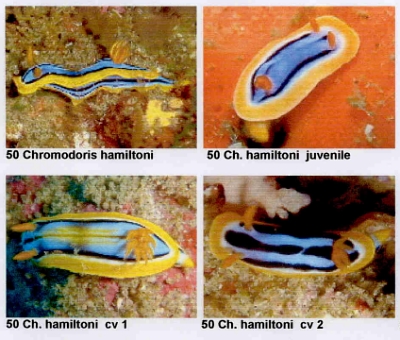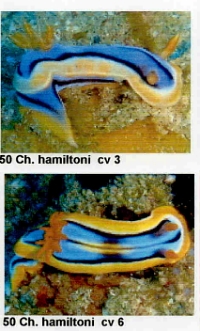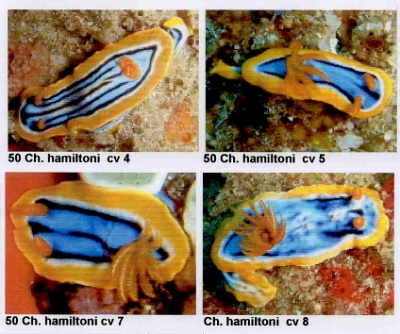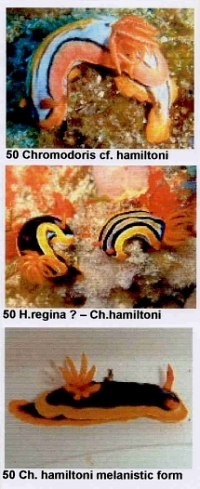Variations in Chromodoris hamiltoni
April 28, 2008
From: Colin Ogden

Hi Bill,
Following all the discussion about Chromodoris hamiltoni, I have prepared pictures of all the variations on C. hamiltoni we see here. I have put all the predominantly blue ones on this sheet, and will send a separate message of the orange form [#20569 ].
C. hamiltoni is probably the most often encountered nudi here. In fact on one of our dives today we must have seen at least 40 separate individuals.
The differences are as follows - see names on the photos:
Chromodoris hamiltoni - most consistent form
Ch. hamiltoni juvenile and cv 7 are both juveniles though the middle black line on cv7 is much stronger than on the first juvenile. Both have a pronounced inner white border to their mantle.
cv1 has an orange section surrounded by blue on its mantle.
cv2 has much thicker black markings. (I at first thought it might be a C. strigata, and I still have doubts on it being C. hamiltoni at all but it was slightly smaller that the normal fully grown adult C. hamiltoni )
cv3 has a "washed out" orange border to its mantle.
cv4 has more black lines than normal, and a good white inner ring on its mantle.
cv5 adult with a good white inner ring.
cv6 darker section between the black lines on its back.
cv8 mottled blue on its back.
cf. hamiltoni different colour almost peach colour rather than orange edge to its mantle.
The other 2 are of a melanistic form.
Locality: Sodwana Bay, 10 to 30 metres, South Africa, Indian, various, reef. Length: 10 mm to 50mm. Photographer: Colin Ogden.
Regards
Colin
scubaco@iafrica.com



Dear Colin,
Thanks for this comprehensive collection. In Tanzania Chromodoris hamiltoni often had an orange patch in the middle of the back and often the middle part of the black lines were orange instead of black. I also saw animals with the 'peach' coloured border as in your cf. hamiltoni.
I have some doubts about the ones you have doubts with ie; Ch. hamiltoni juvenile, cv 2, cv 7., but I am afraid I can't make any sensible comments other than 'gut feelings' are often worth following up.
Concerning the 'melanistic' ones. I have discussed these previously - and changed my mind [see message #18677]. I initially thought they were melanistic C. hamiltoni but later, on the basis of some other photos from Erwin Koehler, and some on their food sponge, I came to the conclusion they were melanistic Hypselodoris regina. Since we have no actual observations of C. hamiltoni feeding on any sponge I am still open to changing my mind again if you can find 'good' C. hamiltoni feeding on a this dysideid sponge. While most species of Chromodoris feed on darwinellid sponges, C. hamiltoni, in colour at least, belongs to a group of species which shows a rather unusual choice of food sponges. So what I am trying to say I guess is can you look out for C. hamiltoni feeding please. I realise that it is often the most common species which are the most difficult to find feeding - I know that sounds strange but there seems to be some inverse law of nature which says that the more common a species is the more difficult it is to find it 'doing things'.
The only clues I can give you is that Pika & Faulkner (1995) and McPhail & Davies-Coleman (1997) both recorded finding chemicals in C. hamiltoni which are almost certainly from bright red sponges of the genus Negombata.
- McPhail, K. & Davies-Coleman, M.T. (1997) New spongiane diterpenes from the East African Nudibranch Chromodoris hamiltoni. Tetrahedron, 53(13): 4655-4660
- Pika, J. & Faulkner, D. J. (1995) Unusual chlorinated Homo-Diterpenes from the South African nudibranch Chromodoris hamiltoni. Tetrahedron, 51, 8189–8198.
Best wishes,
Bill Rudman
Related messages
-
Chromodoris elisabethina? from South Africa
From: Henning Brodersen, May 5, 2010 -
Chromodoris hamiltoni from Madagascar
From: Sully Bachel, May 21, 2009 -
Chromodoris hamiltoni tasting? a hydroid.
From: Colin Ogden, September 10, 2008 -
Chromodoris hamiltoni feeding on black sponge? [2]
From: Colin Ogden, September 10, 2008 -
Chromodoris hamiltoni feeding on black sponge? [1]
From: Colin Ogden, September 10, 2008 -
Chromodoris hamiltoni feeding on orange sponge
From: Colin Ogden, September 10, 2008 -
Chromodoris hamiltoni feeding on various sponges
From: Colin Ogden, September 10, 2008 -
Chromodoris hamiltoni? from South Africa
From: Sylvain Le Bris, May 1, 2008 -
Re: More Chromodoris hamiltoni from Tofo, Mozambique
From: Colin Ogden, April 28, 2008 -
Orange form of Chromodoris hamiltoni
From: Colin Ogden, April 28, 2008 -
Re: More Chromodoris hamiltoni from Tofo, Mozambique
From: Natasja Vandeperre, August 29, 2007 -
More Chromodoris hamiltoni from Tofo, Mozambique
From: Natasja Vandeperre, August 26, 2007 -
Another Chromodoris hamiltoni from Tofo, Mozambique
From: Natasja Vandeperre, August 22, 2007 -
Chromodoris hamiltoni feeding? from Mozambique [1]
From: Natasja Vandeperre, August 22, 2007 -
Chromodoris hamiltoni & C. quadricolor near Pemba?
From: Rob Veelenturf, April 17, 2006 -
Chromodoris elisabethina from South Africa
From: Riaan Marx, April 22, 2005 -
Chromodoris hamiltoni from Reunion Island
From: Philibert Bidgrain, March 9, 2005 -
Chromodoris hamiltoni from Mozambique
From: Charles Rowe, January 28, 2005 -
Chromodoris hamiltoni from Sodwana
From: Charles Rowe, October 8, 2003 -
Chromodoris hamiltoni from Pemba
From: Paul Young , November 18, 2002 -
Chromodoris hamiltoni from South Africa
From: Linda Penny, May 21, 2002 -
Chromodoris hamiltoni from east Africa
From: Bernard Picton, July 5, 2001 -
Pale version of Chromodoris hamiltoni?
From: Valda Fraser, May 6, 2000 -
Chromodoris hamiltoni? from South Africa
From: Valda Fraser, May 5, 2000 -
Colour variation in Chromodoris hamiltoni
From: Valda Fraser, February 14, 2000 -
Chromodoris hamiltoni from South Africa
From: Valda Fraser, February 11, 2000
